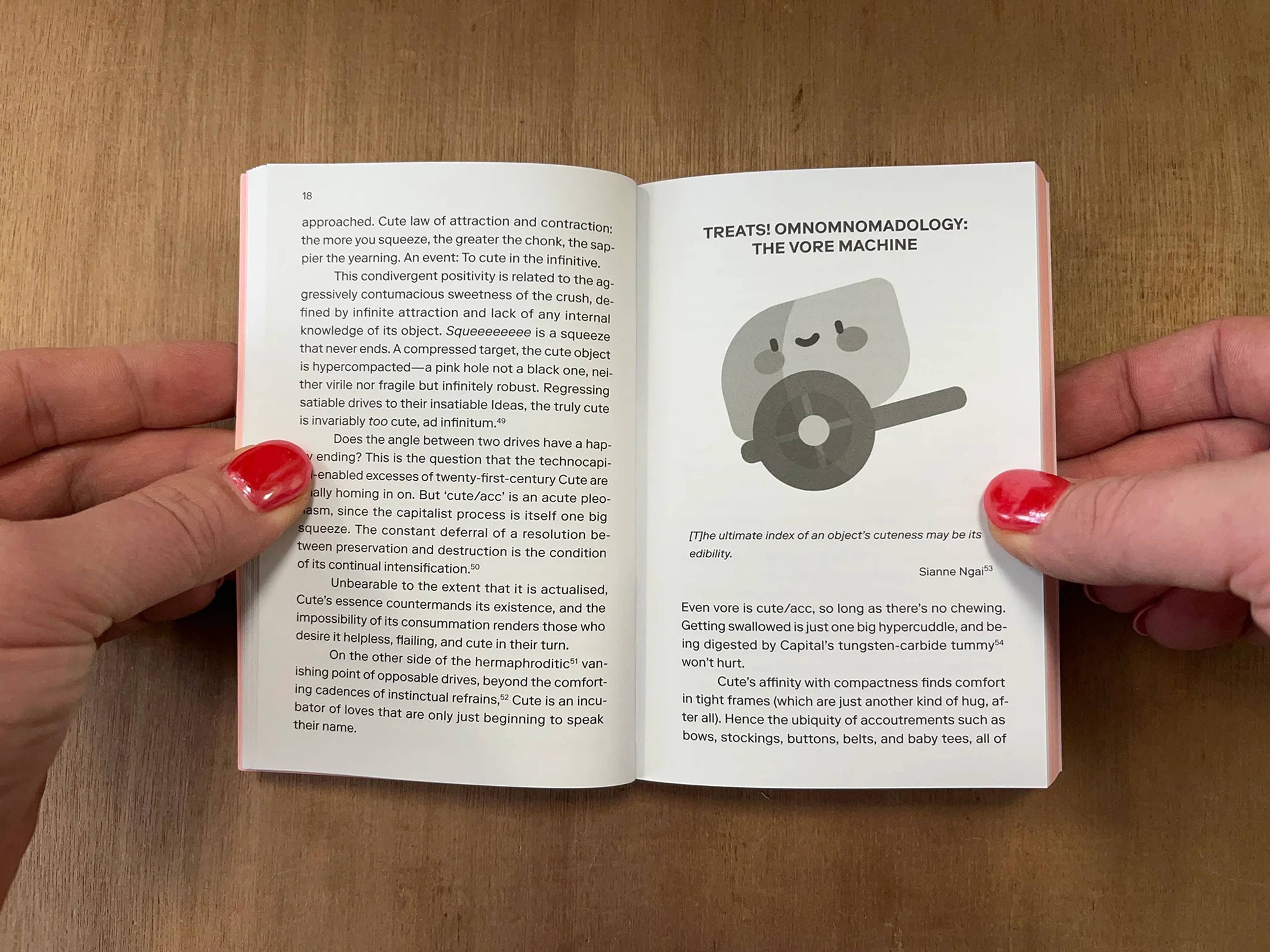Accelerationism is a fraught term, and it tends to elicit visceral, libidinally charged responses. Mention it, and you will likely be met with either condescension or conspiratorial enthusiasm. This despite the fact that accelerationism is not a coherent and self-contained theory, but a series of heterogeneous accelerationisms, to use philosopher Maya B. Kronic’s phrasing. Since the term’s popularization in 2010, hot on the heels of the financial crisis, we have seen numerous competing factions emerge, including unconditional-, gender-, effective-, black-, left-, and right-accelerationisms. Although the touchpoints of these strains of thought range from Marx and post-war cybernetics to the paranormal and post-1968 French theory, they tend to orbit around a central term: the future. Humanity finds itself at a tipping point co-articulated by capitalism’s merciless deterritorializations and its advanced technological developments. For many commentators, the situation engenders despair – or cold militancy.
Kronic and their co-author, Amy Ireland, propose another approach entirely. Fifteen years of deep engagement with accelerationist ideas have yielded Cute Accelerationism, a brazen and sweepingly anti-disciplinary tract, that opens with a surprising position: “Cute made us pliable with the promise of unknown pleasures, lured us with glimpses of a different meltdown in which, instead of portentous historical singularity and apocalypse, soft thresholds are continually dissolved by currents of joyful abandon.” For the authors, cuteness is not an object but a process, and our conversation fittingly became a site for its enactment, tapping into such instantiations as demonic possession, PC Music, and the relationship between sensation and conceptual work.
Amy Ireland & Maya B. Kronic, Cute Accelerationism, 2024. Courtesy: Urbanomic
Alexander Iadarola: Accelerationism often expresses itself through a cybergothic aesthetic suited to a relatively trad, masculine perspective – it isn’t unheard of for the vernacular to veer into incel/ keyboard-warrior territory. Cuteness is so at odds with this gloomy mode of thought – how did you arrive here?
Maya B. Kronic: The “classic” model of accelerationism offers a somewhat macho, martial vision of an ominous future where we’re all going to have to be grim, hard, and cold in order to side with intelligence – with the steely, robotic AIs that are being sent back by Skynet. But, there’s that 2014 Reddit/ AMA with [inventor of the World Wide Web, HTML, and URLs] Tim Berners-Lee where he’s asked, “What’s the one thing that’s truly unpredictable that you couldn’t possibly imagine was going to happen through the power of the internet?” He just says, “Kittens.” I think there’s something profound in that: We have to revise our models of what the true harbingers of the future are, we have to revise our models to make an account of the intense points within technological network culture that are really transforming us and our relationships to others, to ourselves, and to the machines that we interact with.
Amy Ireland: Amid the larger culture wars, there was this micro-war that started around 2017 between unconditional accelerationisms: the trads, right accelerationists, gender accelerationists, all this stuff. Part of that was this race to be darker and more hardcore than everyone else, to be more like, “I can handle reality and you can’t.” The way that you would 1-up someone was by being more in touch with capital-r “Reality.”
But the dehumanizing vector in culture is no longer Terminator [1984]. Right now, it’s dollification: people getting cosmetic surgery to look like dolls, makeup tutorials, nail art, cat ears, miniskirts on boys, DIY endocrine experimentation. All of this belongs to a very different idea of what counts as futuristic technology from the iconic Terminator skull. The future isn’t sending robots to hunt us down and kill us; it’s already inside us, turning us into cute objects as we tumble inexorably toward the great asymptotic kitten outside history. It’s the explosion of integral selfhood into a database of libidinal fragments, or “moé-elements,” that displaces binary gender: It’s the interminable pursuit of the obscure state of “just-rightness” that is inherent to cuteness – along with the temporal distortions peculiar to all of these things.
MBK: We are gradually coming to perceive even ourselves through the filters, algorithms, and two-dimensional space through which we relate to the rest of the world. All of the qualities that involves – flatness, plasticity, virality – find an acute locus within the culture of cuteness –
A. Ireland: – flatness as the emptying out of interiority, until there’s nothing but surface … the great ephemeral skin. Its feedback loop runs through visuality, flatness, and two-dimensionality, and spreads, via the internet and other media, to the tactile, three-dimensional, embodied, material world, then back to flatness. It has a positive relationship with discursivity, with mediation, with images, with the production of images. For cute, reality is immanent to fiction.
Accelerationism doesn’t just offer a theory of history that ends in Ray Kurzweil’s singularity or some shit like that. From a philosophical point of view, the idea is that something is changing human culture. It’s been doing this in concert with the historical emergence of capitalism, but it has this structure where what is happening can only be understood in posteriority. Human culture is being anastrophically guided toward assembling the future. It’s not about us humans imposing our will on history. The human subject has to be open to channeling the forces coming from this future that is assembling itself through human culture.
MBK: In the first chapter of our book, we tried to produce the most compressed, pithy formulations of what we think accelerationism is. One is: “submit to the future early enough to play a part in making it too late to turn back.” It’s this libidinal investment in the future that precipitates the future, in a paradoxical circuit which is continually scrambling itself and producing intensity. Making that investment, flinging yourself into the future in a way that places you at its mercy, involves both a certain passivity and a reckless yet determined effort to abandon identity and stability.
Hopefully, when we present this to people – “here’s the philosophical account of the core dynamic of what accelerationism is … and it’s exactly the same thing as falling in love or being cute” – we’re throwing a spanner in the works of all these stupid ideas about accelerationism – that it’s all to do with making things worse, or destroying humanity, or bringing forth the great singularity, or whatever. It’s accelerationisms in the plural that are actually what’s interesting; what type you build just depends on where you think the points of ingress of the future are.
The future isn’t sending robots to hunt us down and kill us; it’s already inside us, turning us into cute objects as we tumble inexorably toward the great asymptotic kitten outside history.
A. Iadarola: The reader can discern each of your independent voices within the book, and also their synthesis. On top of all this, Cute Accelerationism is also a love story. Can you help me understand what gave rise to the polyvocality of the text?
MBK: It’s not a rhetorical conceit when we say at the beginning, Cute accelerationism came for us and “rode us,” as they say of the voodoo deities. We went through a process which completely changed our lives, in which we learned to give in and to put our identities and everything that we knew at risk. The book then originated from trying to describe that process and to explain to ourselves: What happened? It was only later that we started to look at the wider culture of cuteness and to connect the two things – to think that maybe we could say something about this broader set of processes that seem to increasingly shape the world at large.
For me, a lot of it was also trying to describe things I was experiencing in terms of gender exploration and transition. I needed to find a philosophical way of talking about that to myself that I found satisfying, because I didn’t find the pre-existing models of talking about it adequate. I found that they all had some kind of hidden moralistic or identitarian content, whereas what I wanted to talk about was a strange, disconcerting ordeal that involved a great deal of joy. Gender exploration is a sensory experience that has to do with undergoing transformations and changing your sense of your own body, and I wanted to see what would happen if I took euphoria as the starting point for thinking about that.
A. Ireland: When you fall in love with someone, you become cute and silly and excited. But it’s also a kind of a demonic thing: It takes you completely off guard and just happens to you – you have no control over it. It’s also kind of inconvenient. Because if you go with it, it completely destroys your life. Are you going to commit to it, or are you going to repress it? Are you going to give in to cuteness, or are you going to hold back, and maybe be miserable? We’ve lived through the fallout of that. Maya was living in a field, I was was living in a tent in the backyard of my brother’s sharehouse. Neither of us had any money. We had a long way to climb back up the ladder towards any kind of stability. Then the pandemic happened, and we were stuck on opposite sides of the world. So, there was this intense sense of being ungrounded by a force that came suddenly out of nowhere, over which we had no choice but to either affirm it or deny it.
Author memes on Cute Accelerationism
A. Iadarola: Amy, you mentioned 90s jungle as a key influence for the Cybernetic Culture Research Unit. [The CCRU was a massively influential research collective that included Kronic, Mark Fisher, Sadie Plant, Nick Land, Kodwo Eshun, and others.] To listen to 4hero, Kemistry & Storm, and A Guy Called Gerald is to hear the world inside-out. It throws into a new light the core mechanics of sensation, technics, and cognition. Cute Accelerationism frequently draws on the influence of contemporary electronic music and pop. There are references to PC Music, nightcore, and more.
MBK: Going back to that Warwick moment, there was the idea that sound is a particularly plastic form, in which one can often get a glimpse of operations like deterritorialization and decoding. One can have a sensory experience of disruptions and disorientations that are going to come upon us in the future. In the 90s, it felt too fast to mentally keep up with, where you couldn’t tell whether you were listening to humans or machines, a music that performed strange operations on time. The plastic machine power to abstract and manipulate sound always had a certain kinship with theory. In real conceptual work, you’re trying to take the predetermined coordinates of thinking and break them down or twist them, get down to a lower material level where you can produce new configurations that wouldn’t make sense within the standard grammars of thought.
Through all the years I’ve been running Urbanomic, we’ve done a lot of collaborations with producers and sound artists. There are various different interesting articulations between philosophy, sound, and music, and particularly what Steve Goodman calls the hyperdub continuum, the lineage of music that goes through dub, hip hop, rave, jungle, and now footwork and juke, a lineage which has very often been to do with deliberately identifying with the alien, the machinic, or the nonhuman. It’s often been that the people who are making this music are continually pushing at the edges of the human, putting you in a place where you no can no longer understand yourself as the traditional human subject.
When I discovered SOPHIE and PC Music and started listening to what they were doing, I saw them taking to another level and in another direction the incredible capacity of digital technology to plasticize, rubberize, pull apart sound and reconfigure it in new ways. It wasn’t dark, hard-edged, or frenetically machinic. It was bouncy, extremely bright in an often quite silly way, and used the voice far more – high-pitched voices, boinging sounds, the brightness of FM synthesis, and the brilliant superficialities of pop music. I was like, “Okay, there’s something in this music that hasn’t fully unfolded, and that we can't quite come to terms with yet.” In this instance, it was cute.
I feel like you can’t “faithfully” represent sensation in writing, but there is some kind of discipline to transmuting it into concepts: try to let the concepts emerge from the sensations rather than apply concepts to them. If you believe, as I do, that “capitalist culture” genuinely produces new types of sensation, then it’s important to allow them to speak through conceptual work, because it’s too easy to just apply the categories we already have and flatten them. This is why Deleuze and Guattari’s understanding of capitalism is so important: Ambivalence is at the heart of it. Capitalism genuinely unleashes potentially liberatory novelty, it releases matter from preexisting codes and allows it to enter into new configurations, as well as locking everything down into newly coded forms. This is deeply connected to Deleuze’s underlying philosophical position: Concepts don’t preexist sensation, because difference comes out of encounters with sensation. That opens up a space for thinking about “aesthetic novelty” as something other than just “more capitalist stuff which is actually just the same thing.” From small sensations, great becomings evolve. Each in their own way, the artists on PC Music were obviously involved in this kind of extreme engineering of affect and pursuit of sensation. They were taking tropes from pop music, homing in on them, heightening them, making them more acute. It has an immediate relation to the concept of cuteness, which is always, already, too much. Cuteness is always too cute. It’s always so cute I could die.
___
Cute Accelerationism (2024) is published by Urbanomic.
Maya B. Kronic is Head of Research and Development at the publisher Urbanomic, where they co-edited the #ACCELERATE reader, among many other influential texts; they were also involved with the hugely influential Cybernetic Culture Research Unit (CCRU) in Warwick during the 90s.
Amy Ireland is a member of Laboria Cuboniks, the collective behind The Xenofeminist Manifesto: A Politics for Alienation, and also co-edited the 2016 collection Aesthetics After Finitude. In Spike #70 – Web3, she wrote on crypto’s relationship to patriarchy.









